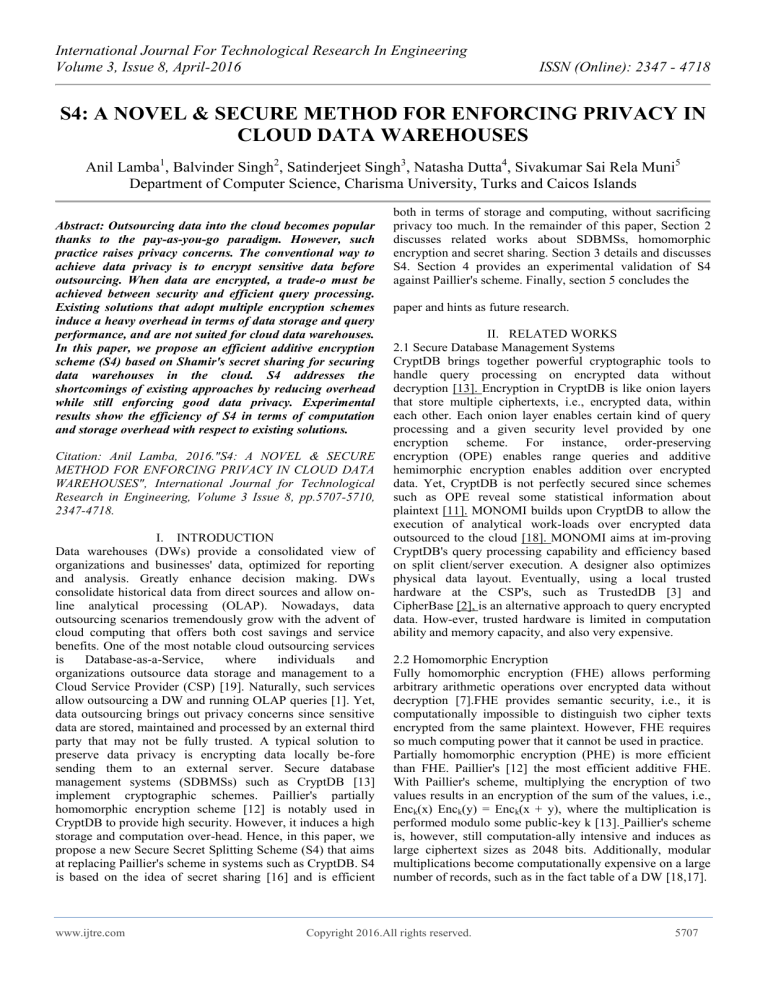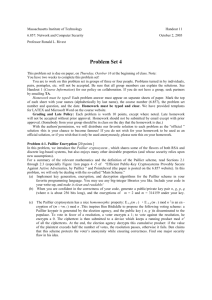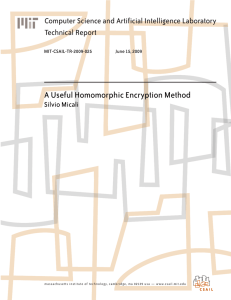
International Journal For Technological Research In Engineering
Volume 3, Issue 8, April-2016
ISSN (Online): 2347 - 4718
S4: A NOVEL & SECURE METHOD FOR ENFORCING PRIVACY IN
CLOUD DATA WAREHOUSES
Anil Lamba1, Balvinder Singh2, Satinderjeet Singh3, Natasha Dutta4, Sivakumar Sai Rela Muni5
Department of Computer Science, Charisma University, Turks and Caicos Islands
Abstract: Outsourcing data into the cloud becomes popular
thanks to the pay-as-you-go paradigm. However, such
practice raises privacy concerns. The conventional way to
achieve data privacy is to encrypt sensitive data before
outsourcing. When data are encrypted, a trade-o must be
achieved between security and efficient query processing.
Existing solutions that adopt multiple encryption schemes
induce a heavy overhead in terms of data storage and query
performance, and are not suited for cloud data warehouses.
In this paper, we propose an efficient additive encryption
scheme (S4) based on Shamir's secret sharing for securing
data warehouses in the cloud. S4 addresses the
shortcomings of existing approaches by reducing overhead
while still enforcing good data privacy. Experimental
results show the efficiency of S4 in terms of computation
and storage overhead with respect to existing solutions.
Citation: Anil Lamba, 2016."S4: A NOVEL & SECURE
METHOD FOR ENFORCING PRIVACY IN CLOUD DATA
WAREHOUSES", International Journal for Technological
Research in Engineering, Volume 3 Issue 8, pp.5707-5710,
2347-4718.
I. INTRODUCTION
Data warehouses (DWs) provide a consolidated view of
organizations and businesses' data, optimized for reporting
and analysis. Greatly enhance decision making. DWs
consolidate historical data from direct sources and allow online analytical processing (OLAP). Nowadays, data
outsourcing scenarios tremendously grow with the advent of
cloud computing that offers both cost savings and service
benefits. One of the most notable cloud outsourcing services
is
Database-as-a-Service,
where
individuals
and
organizations outsource data storage and management to a
Cloud Service Provider (CSP) [19]. Naturally, such services
allow outsourcing a DW and running OLAP queries [1]. Yet,
data outsourcing brings out privacy concerns since sensitive
data are stored, maintained and processed by an external third
party that may not be fully trusted. A typical solution to
preserve data privacy is encrypting data locally be-fore
sending them to an external server. Secure database
management systems (SDBMSs) such as CryptDB [13]
implement cryptographic schemes. Paillier's partially
homomorphic encryption scheme [12] is notably used in
CryptDB to provide high security. However, it induces a high
storage and computation over-head. Hence, in this paper, we
propose a new Secure Secret Splitting Scheme (S4) that aims
at replacing Paillier's scheme in systems such as CryptDB. S4
is based on the idea of secret sharing [16] and is efficient
www.ijtre.com
both in terms of storage and computing, without sacrificing
privacy too much. In the remainder of this paper, Section 2
discusses related works about SDBMSs, homomorphic
encryption and secret sharing. Section 3 details and discusses
S4. Section 4 provides an experimental validation of S4
against Paillier's scheme. Finally, section 5 concludes the
paper and hints as future research.
II. RELATED WORKS
2.1 Secure Database Management Systems
CryptDB brings together powerful cryptographic tools to
handle query processing on encrypted data without
decryption [13]. Encryption in CryptDB is like onion layers
that store multiple ciphertexts, i.e., encrypted data, within
each other. Each onion layer enables certain kind of query
processing and a given security level provided by one
encryption scheme. For instance, order-preserving
encryption (OPE) enables range queries and additive
hemimorphic encryption enables addition over encrypted
data. Yet, CryptDB is not perfectly secured since schemes
such as OPE reveal some statistical information about
plaintext [11]. MONOMI builds upon CryptDB to allow the
execution of analytical work-loads over encrypted data
outsourced to the cloud [18]. MONOMI aims at im-proving
CryptDB's query processing capability and efficiency based
on split client/server execution. A designer also optimizes
physical data layout. Eventually, using a local trusted
hardware at the CSP's, such as TrustedDB [3] and
CipherBase [2], is an alternative approach to query encrypted
data. How-ever, trusted hardware is limited in computation
ability and memory capacity, and also very expensive.
2.2 Homomorphic Encryption
Fully homomorphic encryption (FHE) allows performing
arbitrary arithmetic operations over encrypted data without
decryption [7].FHE provides semantic security, i.e., it is
computationally impossible to distinguish two cipher texts
encrypted from the same plaintext. However, FHE requires
so much computing power that it cannot be used in practice.
Partially homomorphic encryption (PHE) is more efficient
than FHE. Paillier's [12] the most efficient additive FHE.
With Paillier's scheme, multiplying the encryption of two
values results in an encryption of the sum of the values, i.e.,
Enck(x) Enck(y) = Enck(x + y), where the multiplication is
performed modulo some public-key k [13]. Paillier's scheme
is, however, still computation-ally intensive and induces as
large ciphertext sizes as 2048 bits. Additionally, modular
multiplications become computationally expensive on a large
number of records, such as in the fact table of a DW [18,17].
Copyright 2016.All rights reserved.
5707
International Journal For Technological Research In Engineering
Volume 3, Issue 8, April-2016
2.3Secret Sharing
Secret sharing divides a secret piece of data into so-called
shares that are stored at n participants'. A subset of k n
participants is required to reconstruct the secret. In Shamir's,
the rst secret sharing scheme [16], to share a secret vj, a
random polynomial Pvj (x) of degree k 1 is rst built. The
owner of the secret chooses a prime p > vj and k 1 random
numbers a1; a2; :::; ak1 from Fp; and sets a0 = vj (Equation 1).
Pvj (x) passes through the point (0; vj).
Pvj (x) = ak1xk1 + ::: + a1x + a0
mod p (1)
To build n points over Pvj (x), a set of n distinct elements in
Fp, X = fx1; x2; : : : ; xng, is chosen such that xi 6= 0 8i = 1;
:::; n: For each participant i, the corresponding share is vi;j =
Pvj (xi). For each secret vj, there are n points (xi; vi;j) through
which the polynomial P vj (x) passes [8]. Any k shares form k
points (xi; vi;j) i = 1; : : : k, from which polynomial P vj (x) can
be reconstructed using Lagrange interpolation [5] (Equation
2).
where (xi ---- xj) 1 is the multiplicative inverse of (xi xj)
modulo p [5].
Eventually, the secret is the constant term of the polynomial:
III. S4
S4's driving idea is based on secret sharing, but instead of
sharing secrets to n participants' or CSPs', they are stored at
one single CSP's. Thus, we avoid the high storage overhead
of secret sharing. In S4, each secret vj is divided into n = k
splits v1;j; :::; vk;j. k 1 splits, v1;j; :::; vk1;j, are stored at the
CSP's and vk;j is stored in a trusted machine, e.g., at the user's
(Figure 1). In order to reduce storage overhead at the user's,
vk;j is set to be the same for all secrets.
ISSN (Online): 2347 - 4718
k--2 points (ai; bi); i = 1; :::; k 2 are chosen randomly from F p
such that ai 6= xk and ai 6= 0 8i = 1; :::; k 2. Given k points
(a1; b1); (a2; b2); :::; (ak2; bk2), (0; vj) and (xk; vk), polynomial
Pvj (x) is built using Equation 2. Storing the k 2 ran-dom
points is unnecessary because they are not needed for secret
reconstruction.To divide vj into k 1 splits (since (xk; vk) is
already xed), a set of k 1 distinct elements X = fx1; x2; : : : ;
xk 1g is chosen from Fp such that xi 6= 0and xi 6= xk 8i = 1;
:::; k 1. Then, splits are vi;j = Pvj (xi). K=(X; (xk; vk)) is
considered as a private key for S4 and must be kept hidden
from the CSP. Tore construct secret vj, its k 1 splits must be
retrieved from the CSP. Given points (xi; vi;j), i = 1; :::; k 1
and (xk; vk), which is stored at the user's, polynomial P vj (x)
can be reconstructed using Equation 2. Its constant term is vj.
3.2 Summation Queries
Let a relational table T consist of one attribute A (additional
attributes, if any, can be processed similarly). Suppose T has
m records. We denote by vj the jth value of A. For attribute A
in T , k 1 attributes Ai, i = 1; :::; k 1 are created in table T 0 at
the CSP's, where each attribute Ai stores the ith splits.
Without loss of generality, we assume integer data type for
A. Other data types can be transformed into integers before
splitting. S4 allows summation queries to be computed
directly at the CSP's. Consider a query that sums q values of
A.
Then, SUM1, SUM2,..., SUMk1 are shipped back to the user
and polynomial PSUM(x) is built using Equation 2 using k
points
3.1 Splitting and Reconstruction Processes
First, xk and vk are randomly set up from Fp, where p is a big
prime number, i.e., greater than the greatest possible query
answer. For any secret vj, a random polynomial Pvj (x) is built
that passes through (0; vj) and (xk; vk). To this end,
PSUM(x)'s constant term is SUM. S4 does not alter the
number of records. Hence, COUNT queries can be processed
normally, thus also allowing AVG queries.
www.ijtre.com
Copyright 2016.All rights reserved.
5708
International Journal For Technological Research In Engineering
Volume 3, Issue 8, April-2016
3.3 Security Analysis
Paillier's PHE is semantically secure, but it is too expensive
in terms of cipher-text storage space and query response
time. S4 proposes a classical trade-o with a lower level of
security, but better storage and response time e ciency
Let us consider a scenario where the CSP is said honest but
curious, which is a widely used adversary model for cloud
data outsourcing [15]. Such a CSP faithfully complies to any
service-level agreement and, in our particular case, stores
data, runs queries and provides results without alteration,
malicious or otherwise. Yet, the CSP may access data and
infer information from queries and results.
Privacy in S4 relies on the fact that a secret value is only
retrievable by the
user via private key K. As in secret sharing, it is indeed
guaranteed that at least k splits and X are necessary to
reconstruct a secret, while the CSP has access to only k 1
splits. Both X and the kth split, i.e., K, are stored at the user's.
However, the CSP still has access to linear combinations of
splits (Equation 2), which provide some information. Still,
the higher k is, the more di cult it is to interpret linear
combinations of splits. Thus, k is the prime security
parameter in S4. Experiments in Section 4 provide hints for
choosing k.
Moreover, if some secrets are known by the CSP, e.g.,
through public communication of a company to its
shareholders, solving Equation 3 becomes possible. For
example, if the CSP knows secrets v1; :::; vk1. Also knowing
the correspond-ing splits v1;j; :::; vk1;j 8j 2 [1; k 1], the CSP
can recover the Lagrange basis polynomials `i(0) 8i 2 [1; k]
and solve Equation 3 to recover all secrets. However, the
CSP must know at least k 1 secrets to do so. Moreover, we
also propose leads to address this problem in Section 5.
IV. EXPERIMENTAL EVALUATION
4.1 Experimental Setup
We implement S4 in C using compiler gcc 4.8.2. S4's source
code is freely available on-line1. Experiments related to
Paillier's PHE exploit the libpaillier standard C library [4].
All mathematical computations use the GNU Multiple
Precision Arithmetic Library (GMP) [6]. Eventually, we
conduct our experiments on an Intel Core i7 3.10 GHz PC
with 16 GB of RAM running Linux Ubuntu 15.05.
We compare S4 and Paillier's PHE using simple synthetic
datasets, i.e., 32-bit unsigned integers generated uniformly at
random from the integer range [103; 104[. We scale up the
number of records m such that m 2 (103, 104, 105, 106),
forming four distinct datasets.
In S4, we vary k from 8 to 64, higher values of k inducing
too long execution Pm times. Prime p must be greater than
the greatest query answer, e.g., p > j=1 vj. In Paillier's PHE,
we use a key size of 1024 bits, which induces ciphertexts of
www.ijtre.com
ISSN (Online): 2347 - 4718
2048 bits. Such key size is the absolute minimum to achieve
security [9,20].
4.2
Encryption and Decryption Time
Figure 2 plots the time of secret splitting in S4 and secret
encryption in Paillier's scheme with respect to m. It shows
that encryption time in S4 is lower than Paillier's when k 16,
and then becomes higher when k 16. Secret splitting consists
in building a random polynomial by randomly choosing k 2
points. Hence, splitting time increases with k. Figure 2
actually illustrates the tradeo between S4's security and
encryption efficiency with respect to Paillier's PHE.
Figure 3 plots the time of secret reconstruction in S4 and
secret decryption in Paillier's scheme with respect to m. With
the selected values of k, decryption is faster with S4 than
with Paillier's PHE. This is mainly because Paillier's scheme
needs m expensive modular multiplications of large, 2048-bit
numbers for decryption, while secret reconstruction in S4
works by polynomial interpolation over k points and
evaluating the polynomial in one single point.
Fig. 2: Splitting/encryption time
Fig. 3: Reconstruction/decryption time
4.3
Space Overhead
Figure 4 plots the storage required by S4 and Paillier's PHE
with respect to m. With the selected values of k, S4's storage
overhead is always much smaller than that of Paillier's PHE
since Figure 4's y axis follows a logarithmic scale. Paillier's
scheme indeed produces 2048-bit cipher texts. Thus, its
storage overhead is m 2048. With S4, each value is split into
k 1 values. Thus, S4's storage overhead is m (k 1) times
plaintext size.
4.4
Query Processing Time
Figure 5 plots summation query processing times over all
records in each dataset, for both S4 and Paillier's PHE, with
respect to m. It shows that, with the selected values of k,
query execution time in S4 is lower than that of Paillier's
scheme. This is because Paillier's scheme requires m
expensive modular multiplications to compute a sum, while
S4 computes only (k 1) m simple modular additions.
Copyright 2016.All rights reserved.
5709
International Journal For Technological Research In Engineering
Volume 3, Issue 8, April-2016
[4]
[5]
[6]
[7]
[8]
Fig. 4: Storage overhead
Fig. 5: Summation execution time
V. CONCLUSION
In this paper, we introduce S4, a new cryptographic scheme
that supports summation queries in cloud-based OLAP. We
experimentally show that S4 is much more efficient than
Paillier's PHE in terms of query response time and space
overhead. Thus, replacing Paillier's scheme with S4 in secure
DBMSs such as CryptDB and MONOMI can improve
analytical query processing in cloud DWs. Moreover, we also
plan a variant of S4 for computing multiplications. However,
we achieve performance gains through a slight degradation of
se-curity, especially when an adversary has knowledge of
secret values. Although it is definitely acceptable in some
cloud DW and OLAP scenarios, e.g., public aggregate data
might not actually yield secrets, i.e., ne-grained data, we will
devote future research to strengthen S4 against such threats.
More precisely, we plan to introduce noise, as in many
cryptographic problems such as approximate-GCD [10] or
LWE [14]. For instance, instead of sharing vj, we could share
10r vj + noise. By doing so, security is intuitively enhanced
while the whole process remains correct, provided r is
sufficiently large and noise sufficiently small.
REFERENCES
[1] Amanatidis, G., Boldyreva, A., O'Neill, A.:
Provably-secure schemes for basic query support in
outsourced databases. In: 21st IFIP WG 11.3
Working Conference on Data and Applications
Security, Redondo Beach, CA, USA. pp. 14{30
(2007)
[2] Arasu, A., Eguro, K., Joglekar, M., Kaushik, R.,
Kossmann, D., Ramamurthy, R.: Transaction
processing on con dential data using cipherbase. In:
31st IEEE International Conference on Data
Engineering, ICDE, Seoul, South Korea. pp.
435{446 (2015)
[3] Bajaj, S., Sion, R.: TrustedDB: a trusted hardware
based database with privacy and data con dentiality.
In: International Conference on Management of
www.ijtre.com
ISSN (Online): 2347 - 4718
Data, SIGMOD, Athens, Greece. pp. 205{216
(2011)
Bethencourt,
J.:
Paillier
library.
http://acsc.cs.utexas.edu/libpaillier/ (last ac-cessed:
2016)
Dautrich, J.L., Ravishankar, C.V.: Security
limitations of using secret sharing for data
outsourcing. In: 26th IFIP WG 11.3 Conference in
Data and Applications Security and Privacy, Paris,
France. pp. 145{160 (2012)
Free Software Foundation: GNU Multiple
Precision Arithmetic library. https://gmplib.org/
(last accessed: 2016)
Gentry, C.: A fully homomorphic encryption
scheme. Ph.D. thesis, Stanford Uni-versity (2009)
Hadavi, M.A., Jalili, R., Damiani, E., Cimato, S.:
Security and searchability in se-cret sharing-based
data outsourcing. International Journal of
Information Security 14(6), 513{529 (2015)
[9] Jost, C., Lam, H., Maximov, A., Smeets, B.J.M.:
Encryption Performance Improve-ments of the
Paillier Cryptosystem. IACR Cryptology ePrint
Archive 864 (2015), http://eprint.iacr.org/2015/864
[10] Liu, D.: Practical Fully Homomorphic Encryption
without Noise Reduction. IACR Cryptology ePrint
Archive 468 (2015), http://eprint.iacr.org/2015/468
[11] Naveed, M., Kamara, S., Wright, C.V.: Inference
attacks on property-preserving encrypted databases.
In: 22nd ACM SIGSAC Conference on Computer
and Com-munications Security, Denver, CO, USA.
pp. 644{655 (2015)
[12] Paillier, P.: Public-key cryptosystems based on
composite degree residuosity classes. In:
International Conference on the Theory and
Application of Crypto-graphic
Techniques,
EUROCRYPT, Prague, Czech Republic. LNCS,
vol. 1592, pp. 223{238 (1999)
[13] Popa, R.A., Red eld, C.M.S., Zeldovich, N.,
Balakrishnan, H.: CryptDB: protecting con
dentiality with encrypted query processing. In: 23rd
ACM Symposium on Operating Systems Principles,
SOSP, Cascais, Portugal. pp. 85{100 (2011)
[14] Regev, O.: On lattices, learning with errors, random
linear codes, and cryptogra-phy. Journal of the
ACM 56(6) (2009)
[15] Sanamrad, T., Kossmann, D.: Query log attack on
encrypted databases. In: 10th VLDB Workshop on
Secure Data Management, SDM, Trento, Italy. pp.
95{107 (2013)
[16] Shamir, A.: How to share a secret. Communications
of the ACM 22(11), 612{613 (1979)
[17] Sion, R.: Towards Secure Data Outsourcing, pp.
137{161. Springer (2008)
[18] Tu, S., Kaashoek, M.F., Madden, S., Zeldovich, N.:
Processing analytical queries over encrypted data.
Proceedings of the VLDB Endowment 6(5),
289{300 (2013)
Copyright 2016.All rights reserved.
5710
International Journal For Technological Research In Engineering
Volume 3, Issue 8, April-2016
ISSN (Online): 2347 - 4718
[19] Xiong, L., Chitti, S., Liu, L.: Preserving data
privacy in outsourcing data aggre-gation services.
ACM Transactions on Internet Technology 7(3)
(2007)
[20] Yildizli, C., Pedersen, T.B., Saygin, Y., Savas, E.,
Levi, A.: Distributed privacy preserving clustering
via homomorphic secret sharing and its application
to (verti-cally) partitioned spatio-temporal data.
International Journal of Data Warehousing and
Mining 7(1), 46{66 (2011)
www.ijtre.com
Copyright 2016.All rights reserved.
5711




